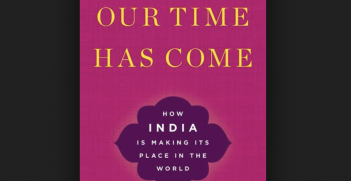Reading Room: Maritime Security in the Indo-Pacific

Regions are not some natural or objective outcome of geography. They are a social construct. The idea of a region creates a mental map of how we view the world, with all the political, economic and military consequences that flow from that. In the 1980s Australia was at the forefront of promoting the idea of the ‘Asia-Pacific’ as a region, one that conveniently bound Australia to the tiger economies of East Asia. Australia is now spearheading the promotion of a broader region, the ‘Indo-Pacific’.
The Indo-Pacific, at least from an Australian perspective, is the strategic arc running along the littoral of the Asian continent from Korea to India. The idea is intended to recognise the increasing economic integration along the Asian littoral (particularly between East and South Asia) and the consequently growing strategic interdependence between the western Pacific and northern Indian Ocean regions. This includes, in particular, the security of the crucial sea lines of communication that run from the Persian Gulf through the Indonesian archipelago to Northeast Asia.
For many Australian practitioners and observers, the Indo-Pacific has become a fairly common way to describe our neighbourhood. Although the popularity of this concept is growing elsewhere, it is easy to forget just how contested this idea is throughout the region.
Mohan Malik’s book, Maritime Security in the Indo-Pacific: Perspectives from China, India and the United States, is a collection of essays that provides an excellent resource for understanding the different perspectives of our region. Malik brings together security experts from those three countries (and Australia as well) to debate the concept of the Indo-Pacific and concurrent developments in regional maritime security.
American perspectives tend to be focused on China and the threat it represents in the South China Sea and the East Asian security order. As US naval analyst Andrew Winner comments, “it is not clear that [the Indo-Pacific] will stick as a conceptual organising principle for thinking about US interests or strategic approaches to the maritime regions of Asia.” This level of scepticism may well be heightened under the Trump administration, especially if the Middle East lobby gains the upper hand. Many US analysts recognise the importance of the US-India relationship but do not necessarily perceive it as part of an integrated web of Indo-Pacific relationships.
Indian analysts are split on the value of the Indo-Pacific concept for India; some recognise the legitimising function of the concept for India’s security role in the Pacific theatre, while others suspect that it is some sort of US plot. In this writer’s view, there has been a significant and positive change in the perspectives of Indian practitioners and analysts towards the Indo-Pacific under the Modi administration, especially in the last year or so. The India-Japan relationship in particular can be sold as an Indo-Pacific partnership.
Of course, Chinese perspectives are the most different and also the most interesting. The Indo-Pacific concept is rarely used in the Chinese literature and, on the whole, it is more or less equated with talk of a quadrilateral alliance among the United States, Japan, India and Australia aimed at containing China. This perspective should be unsurprising given that the majority of proponents of the Indo-Pacific concept in those four countries place the idea in the context of an assertive China and the need to uphold ‘a norm-based regional order’. Thus Yang Yi, Secretary General of the China Institute of International Studies, comments:
As a geopolitical concept, the Indo-Pacific not only reflects changes in the regional economic and political situation, but also embodies the strategic visions of some countries to meet their situational changes and enhance their positions … Based on the policy designs by some scholars and governments, the concept of the Indo-Pacific obviously targets China.
Rather than discussing a concept so strongly focused on security, particularly one perceived to target China, Chinese analysts are more comfortable discussing China’s plans for ‘win-win’ regional economic development. There is now much focus on China’s One Belt One Road (OBOR) initiative, in which China is expanding its economic role through the Indian Ocean region and the Eurasian continent. From a Chinese perspective, this is a very much an economic initiative, although it has some strategic implications.
Some might argue that China’s OBOR initiatives are just the Indo-Pacific with Chinese characteristics. Indeed, in the Australian conception, the Indo-Pacific describes the economic integration between East Asia and the Indian Ocean and the strategic consequences flowing from that. From this perspective OBOR merely proves the positive value of the Indo-Pacific concept.
But there are also important differences: for one thing, Australian perspectives are focused on the maritime domain and maritime security, while Chinese perspectives tend to be much more continental. Most Chinese analysts see the overland economic corridors being carved from China to the Indian Ocean through Pakistan and Myanmar to have greater significance than purely maritime initiatives—and they may be right.
Notwithstanding scepticism about the Indo-Pacific region, the concept has real value for Australia and our neighbourhood. Maritime Security in the Indo-Pacific is a valuable addition to understanding the real differences in perspective in our neighbourhood about the meaning of the Indo-Pacific and its implications for regional security.
Mohan Malik, ed., Maritime Security in the Indo-Pacific: Perspectives from India, China and the United States, Rowman and Littlefield, 2014.
Dr David Brewster is a Senior Research Fellow with the National Security College, Australian National University.





